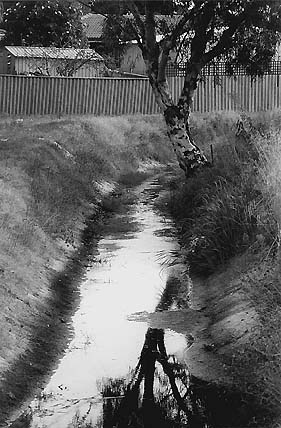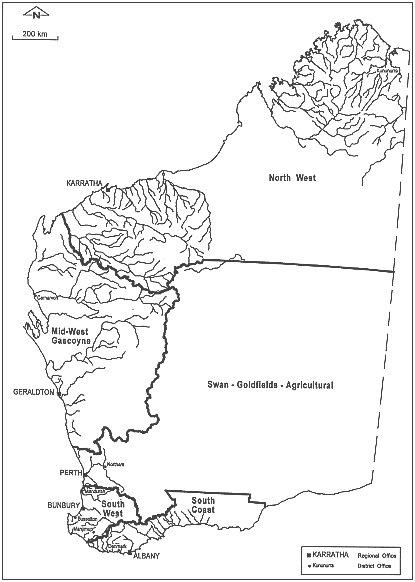
The evolution of waterways management in Western Australia
| Waterways are important for the people of Western Australia. Their waters and foreshores are highly prized because of the basic human desire to live and recreate near water. The estuaries are owned by everybody and used by everybody. As a consequence, many demands are made. Unchecked, these demands can often conflict and result in degradation of water quality and the foreshores. Management and care of waterways must be coordinated to balance all the conflicting demands and protect the environment. |
 |
Waterways management is a relatively new phenomenon in Western Australia. In the early days of European settlement the full importance of rivers and estuaries wasn't understood by the community and government. Waterways were seen as important for transport, water supply, recreation and sometimes for food supply. They were left to look after themselves.
In those early days abuse of waterways was common. Sewage and other waste products were often discharged directly into rivers and estuaries; rubbish dumps were established on the foreshores; and drastic modifications were made to the natural channels of many waterways. At the same time, catchments were cleared and developed.
Waterways management in Western Australia had its first beginnings with the establishment of the Swan River Reference Committee in 1943. The Committee was established as an advisory body to coordinate activities of the multitude of authorities and organisations interested in some way in river usage, works and cleanliness of the foreshores. By this stage there was the beginning of a recognition that waterways - especially the Swan River, for the people of Perth and Western Australia - were an important aesthetic asset of urban and rural Australia
Although the Swan River Reference Committee had no statutory powers, it achieved much, in particular eliminating many points of pollution and contamination. The Swan River Conservation Act 1958 established a board of 17 members known as the Swan River Conservation Board. The legislation was based largely on the experiences of the original committee.
At the time of its introduction the legislation was the first of its type in Australia and was framed on broad lines to give the Board wide powers, subject to the Minister and subject to appeals to the Minister and the Courts. The Board exercised the role of watchdog and coordinator in addition to its major work of monitoring river purity and foreshore cleanliness.
Many factors influenced the need for a single controlling authority for the Swan River. These included the increase in population in the Perth metropolitan area, the Metropolitan Region Planning Authority's proposal for the Metropolitan Region Scheme, the expanding demand for water space for aquatic activities, the need for additional foreshore areas for public recreation and the upsurge of industrial activity.
These demands soon followed in other areas in the State, highlighting the need for more comprehensive waterways management legislation.
On 9 December 1976, the by now amended Swan River Conservation Act was repealed and the Waterways Conservation Act 1976 was established to replace it. Under the Act, any waterway in need of coordinated management could be declared a management area with defined boundaries. The powers under the Act then apply to these management areas so that conservation and management can be achieved. The Act extended to regional communities a statutory role in conservation and management which had up until this time only been available to metropolitan Perth and the Swan River.
With the proclamation of the Act came the establishment of three waterways management authorities: the Swan River Management Authority, the Peel Inlet Management Authority and the Leschenault Inlet Management Authority. Later, in 1991, the Albany Waterways Management Authority was established in 1993, the Avon River Management Authority and in 1994, the Wilson Inlet Management Authority. Gazetted management areas were established in each of these locations.
The waterways management authorities were (and still are today) strongly community-based bodies representing local interests and relevant expertise. Each management authority consists of an independent chairperson, five to eleven people selected (as far as practicable) from people resident in the local community or who represent local government or State government agencies with responsibility for, or special knowledge of, local affairs. Members of the management authorities are appointed by the Governor of Western Australia on recommendation from the Minister for Water Resources.
The Waterways Conservation Act also established the Waterways Commission. The Commission's role was to administer the Act and to support the various waterways management authorities. The management authorities were responsible for administering the provisions of the Act in their specific management areas. The Waterways Commission consisted of the Commissioner for Waterways and the chairperson of each management authority.
The Commission and management authorities were supported by the public sector agency also called the Waterways Commission. The staff provided advisory, research, planning, promotional, construction, pollution control and administrative support necessary to make sure that conservation and effective management of the waterways was achieved. Staff of the Waterways Commission provided professional and administrative support to the Commission and the management authorities.

Figure 8-1: Management authority areas
In 1988 further legislative control was required for management of the Swan-Canning Estuarine System, mainly as a result of development pressure from the growing city of Perth. The Swan River Trust Act 1988 was proclaimed establishing the Swan River Trust to replace the Swan River Management Authority.
Between the years of 1976 and 1995 the Waterways Commission, together with the local waterways management authorities, managed the waterways. The Commission's work fell into four broad programmes:
These were aimed at improving the community's understanding of its waterways so that community members could make informed judgements on the directions and success of waterways management strategies and help to identify potential and actual problems with the waterways. Work in this programme included research, monitoring, identification of standards, investigations and provision of advice on environmental problems.
This was aimed at protecting, conserving and enhancing the waterways and their environment for the long-term enjoyment of the Western Australian community by developing and promoting agreed management approaches for waterways, foreshores and catchment areas. Work in this programme included giving advice to planning authorities about the impact of development on the waterways environment and preparing management strategies, programmes and plans for individual waterways.
This was aimed at protecting the waterways' environment by maintaining and stabilising waterways, including beds, banks and foreshores. The programme included carrying out works to protect the physical environment and providing for public amenities such as boat ramps and jetties.
This was aimed at increasing community awareness of the values of waterways and their appropriate use. Work in this programme involved informing the community about waterways through publications, displays and presentations and assisting the community to become involved and take responsibility for waterways management.
Restructuring of the Western Australian water industry in 1995 led to the roles, staff and waterways management authorities of the former Waterways Commission being included in the new Water and Rivers Commission. The newly formed Commission has the responsibility for the management of all water resources. Minimal changes were made to legislation and management structures, with a new advisory Rivers and Estuaries Council (RAEC) replacing the Waterways Commission. The role of RAEC is to advise the board of the Water and Rivers Commission, which has responsibility for water resource management across the State, on matters concerning waterways management.
The Water and Rivers Commission Act 1995 created the Water and Rivers Commission, absorbing the former Waterways Commission. It continues to bring together the community-based waterways management authorities, which operate under the Waterways Conservation Act. The new Water and Rivers Commission (WRC) has additional responsibilities under the Water and Rivers Act for the five declared management areas and also for hundreds of rivers and about 40 estuaries across the entire State.
The Swan River Trust Act remains separate legislation to the Waterways Conservation Act and the Swan River Trust is a separate management body to the Water and Rivers Commission. However, the chairperson of the Swan River Trust is a member of RAEC and staff of the Swan River Trust are supplied by the WRC.

Figure 8-2: Water and Rivers Commission regions
While the Water and Rivers Commission provides overall coordination and policy direction, the actual tasks of implementing management and works programmes are still undertaken at a local level by waterways management authorities and community groups. Regional and district offices operate in each of the five regions covering the State. These offices provide a range of valuable services:
In 1996 a sixth management body was set up under the Waterways Conservation Act to coordinate the management of the Geographe Bay catchment. This body, known as Geocatch, does not have the full regulatory powers of the Waterways Conservation Act. Its main role is to coordinate a cooperative approach to broad catchment and waterways management by all people who have an interest in the catchment.
|
The Water and Rivers Commission's mission is:
To manage the water resources of Western Australia for the benefit of present and future generations in partnership with the community |
|
The Commission aims to ensure that rivers, streams, wetlands, lakes and estuaries are:
|